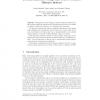Free Online Productivity Tools
i2Speak
i2Symbol
i2OCR
iTex2Img
iWeb2Print
iWeb2Shot
i2Type
iPdf2Split
iPdf2Merge
i2Bopomofo
i2Arabic
i2Style
i2Image
i2PDF
iLatex2Rtf
Sci2ools
LOCA
2005
Springer
2005
Springer
Towards LuxTrace: Using Solar Cells to Measure Distance Indoors
Abstract. Navigation for and tracking of humans within a building usually implies significant infrastructure investment and devices are usually too high in weight and volume to be integrated into garments. We propose a system that relies on existing infrastructure (so requires little infrastructure investment) and is based on a sensor that is low cost, low weight, low volume and can be manufactured to have similar characteristics to everyday clothing (flexible, range of colours). This proposed solution is based on solar modules. This paper investigates their theoretical and practical characteristics in a simplified scenario. Two models based on theory and on experimental results (empirical model) are developed and validated. First distance estimations indicate that an empirical model for a particular scenario achieves an accuracy of 18cm with a confidence of 83%.
Infrastructure Investment | Little Infrastructure Investment | LOCA 2005 | Significant Infrastructure Investment |
| Added | 28 Jun 2010 |
| Updated | 28 Jun 2010 |
| Type | Conference |
| Year | 2005 |
| Where | LOCA |
| Authors | Julian Randall, Oliver Amft, Gerhard Tröster |
Comments (0)

